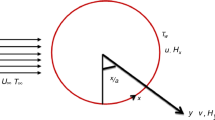Summary
A study is made of the problem of the boundary layer on an infinite horizontal cylinder caused by oscillatory free convection when the temperature of the cylinder oscillates with frequency ω about a mean temperatureT ∞, the temperature of the surrounding fluid. Special attention is given to the steady flow in the outer boundary layer and the appropriate Reynolds number. The governing equations are solved by the method of separation of the steady and the unsteady components of the flow field. It is shown that a large Reynolds number plays a significant role in the formation of the outer boundary layer in the oscillatory convective flows, while in the case of oscillatory flow in which the secondary flow is present due to the Reynolds stresses the large value of the parameterR/S is important.
Riassunto
Si fa uno studio del problema dello strato di confine su un cilindro orizzontale infinito causato da convezione libera oscillatoria quando la temperatura del cilindro oscilla con frequenza ω intorno ad una temperatura mediaT ∞, la temperatura del fluido circostante. Si presta particolare attenzione al flusso stabile nello strato di confine più esterno ed all'appropriato numero di Reynolds. Le equazioni principali sono risolte col metodo della separazione dei componenti stabili e instabili nel campo di flusso. Si mostra che un grande numero di Reynolds ha un ruolo significativo nella formazione di uno strato di confine più esterno nei flussi convettivi oscillatori, mentre nel caso di flusso oscillatorio nel quale il flusso secondario è presente a causa delle tensioni di Reynolds il grande valore del parametroR/S è importante.
Резюме
Исследуется проблема граничного слоя на бесконечном горизонтальном цилиндре, обусловленного осциллирующей свободной конвекцией, когда температура цилиндра осциллирует с частотой ω относительно средней температурыT ∞, температуры окружающей жидкости. Особое внимание уделяется стационарному потоку на внешней стороне граничного слоя и соответствующему числу Рейнольдса. Решаются определяющие уравнения, используя метод разделения стационарной и нестационарной компонент потока. Показывается, что большое число Рейнольдса играет существенную роль в образовании внешнего граничного слоя в осциллирующих конвекционных потоках, тогда как в случае осциллирующего потока, когда присутствует вторичный поток, обусловленный напряжением Рейнольдса, является важным большое значение параметраR/S.
Similar content being viewed by others
References
J. T. Stuart:Journ. Fluid Mech.,24, 673 (1966).
H. Schlichting:Boundary Layer Theory (New York, N. Y., 1968).
N. Riley:Mathematika,12, 161 (1965).
J. H. Merkin:Journ. Fluid Mech.,30, 561 (1967).
Author information
Authors and Affiliations
Additional information
Traduzione a cura della Redazione.
Переведено редакцией.
Rights and permissions
About this article
Cite this article
Chatterjee, A.K., Debnath, L. Double boundary layers in oscillatory convective flow. Nuov Cim B 52, 29–44 (1979). https://doi.org/10.1007/BF02743567
Received:
Published:
Issue Date:
DOI: https://doi.org/10.1007/BF02743567




